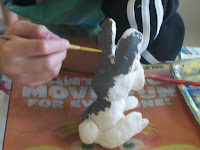“You said no weapons!” complains a 6th
grader witnessing an older student who came to retrieve his model of a “potato
masher” which is a German WWII bomb. “Did I?” I don’t think I have said that
for years. I do know that there is a whole room set aside for weaponry at the
Metropolitan Museum of Art in New York. Somebody must agree with the kids that
weapons can be art!
Later I watched a small clutch of eighth
graders building paper rifles – a craze that started when the first boy crafted
one that had moving action (what’s that part called that you slide down the
barrel and back to reload?) Now three or four others are making variations. I
think there is a shot gun, and a futuristic one…made with such attention to
detail - an eye for proportion, moving
parts, reinforced areas – things of beauty, if you are a 14 year old boy in
Vermont.
I strike up a conversation with these 3D
artists: “Some people might ask if it’s ok to make weapons in school…”
“I say,” replies one student without
missing a beat, “they are made of paper.”
Students know that these objects pose no
threat to anyone. They also know that they are challenging and engaging to
make. There is a lot of problem solving going on, and skill development, and envisioning.
I press on: “what about the concern that
making weapons might lead to violent thought or violent action, that it might
contribute to a culture of violence that glorifies war and killing?”
The conversation that follows goes
something like this: “I am a hunter, I use my gun to hunt deer – not people.”
“I like to target shoot – I do it with my dad.”
“Again” says the first boy, “they are made
of paper!”
Just what are we afraid of, I wonder?
 In elementary school, when a sewing machine was donated to the art studio, it was the boys who sewed pillow after pillow after pillow.
In elementary school, when a sewing machine was donated to the art studio, it was the boys who sewed pillow after pillow after pillow. 
















